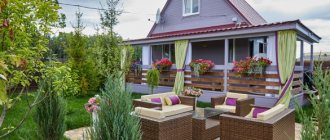By law, a residential building is an individual building that consists of rooms. As well as auxiliary premises intended to satisfy citizens’ household and other needs. Related to their residence in such a building. But let's figure out what a residential building is in reality and in simple words.
What is a residential building
The law says that a residential building is a separate building. That is, there are completely no neighbors in a residential building. And indeed. Where can neighbors come from, this is not an apartment? Which is surrounded by neighbors on all four sides.
A residential building is being built on a separate plot of land, and maybe. Both capital and non-capital buildings.
A capital structure, anchored to the ground by a foundation. The foundation can be of several types, depending on. On what soils it is used and how cheap it is to build a house. The foundation itself is a complex engineering structure. Which is capable of bearing the load of the entire mass of the constructed residential building. There are even special engineering calculators. Which calculate the construction volume of the future foundation depending on the planned area of the residential building.
Important:
The foundation firmly connects the house to the ground, essentially serving as its support. Which evenly distributes the weight of the entire building over its area.
The construction of a house begins with calculations of the foundation required for it. The required foundation is selected for specific tasks. Somewhere the soil freezes very deeply and the foundation must be deepened below the freezing level. And then it is insulated and covered with formwork from natural precipitation.
Somewhere the soil is very swampy and mobile and there is a possibility of the house subsiding. No foundation can withstand such overloads, except for a heavy concrete slab. Poured under the entire foundation of the house and associated reinforcement for structural strength.
In dry and sandy soils, an easy-to-install and affordable pile-screw foundation is used. Which can significantly save the cost of building a residential building. And it installs very quickly.
But such a foundation can only support a house using lightweight building materials. Those who are not so afraid of the mobility of the support. For example, a residential building made of timber, a panel house. As well as a residential building made of rounded logs or vulture panels.
How to change the purpose of a building or premises?
To begin with, let's say that buildings have purposes: residential building, non-residential building, apartment building, residential building and garden house. Premises are residential and non-residential.
According to Part 1 of Article 32 of Law No. 218-FZ, state authorities and local governments are required to send documents (the information contained in them) to the rights registration authority for entering information into the Unified State Register of Real Estate if they make decisions to transfer residential premises to non-residential premises, non-residential premises to the residential premises (if redevelopment work is not required) or on approval of the acceptance committee act (in the case of redevelopment work).
If the information is not entered into the Unified State Register of Real Estate within the time limits established by Article 34 of Law No. 218-FZ, the interested person has the right, in the manner established for submitting an application for state cadastral registration and (or) state registration of rights, to contact the rights registration authority with an application for entering the relevant information into the Unified State Register of Real Estate.
Let us note that the rights registration authority, within 3 working days from the date of receipt of the application for entering the relevant information into the Unified State Register, independently requests documents from state authorities and local governments.
Situations where a house was built on a garden plot of land, which is intended for seasonal use, that is, non-residential purposes, and subsequently converted in such a way that it became possible to live in such a house all year round, occur regularly.
Until recently, changing the use of a garden house was a problem for its owners. However, thanks to the Law on Gardening and Horticulture No. 217-FZ, which has been in force since 2019, it is possible to recognize a garden house as a residential building and vice versa.
To do this, the owner of the house must contact the local government, submitting the following documents:
- application, title document for a garden house or residential building;
- conclusion on the inspection of the technical condition of the object, confirming the compliance of the garden house with the requirements of reliability and safety (established by Part 2 of Article 5, Articles 7, 8 and 10 of the Federal Law “Technical Regulations on the Safety of Buildings and Structures”);
- notarized consent of third parties (if the property is encumbered with the rights of these persons).
Each municipality can independently establish an additional list of documents, so the full list of documents can be found on the official websites of municipalities.
After receiving the Decision, the owner of the building applies to Rosreestr with an application to change the purpose of the property.
Residential building foundation
In order not to go deeper into the construction process, let's briefly look at what types of foundations exist. And what each of them is used for.
- Strip foundations
are simple and cheap to use, but you need to accurately calculate the depth of soil freezing. And control the quality of concrete when pouring it. Otherwise, such a foundation may swell with frozen soil and cracks will appear along the wall of the house. But such a foundation can be built by one family, without involving specialists for the work. The main thing is that someone has experience installing permanent formwork and can calculate the required depth of recess. Houses are usually built on such a foundation, no higher than 2 floors in height. - Pile foundation
- a pile-screw foundation is used where it is necessary to quickly build a house. This type of foundation is being built for light frame houses, houses made of rounded logs or timber. The foundation is built and tied with a grillage to make the structure monolithic in just a week. - Columnar foundation
- Supports are located throughout the entire area of the future house, at a distance of two to three meters from each other. The supports are built from blocks or bricks, and then tied together with a grillage. Again, this is necessary to give the structure strength. This foundation is also simple to implement and can be assembled by a married couple. - Slab foundation
- used in the construction of heavy, multi-story buildings, up to 5 floors in height. Or houses of non-standard designs. A layer of concrete filling the slab under the house. It can reach a thickness of 30 to 110 cm plus reinforcement, which also significantly increases the cost of construction. Therefore, such a foundation is the most expensive of all. And during its construction, one cannot do without the help of specialists. Since the design itself ultimately turns out to be quite complex and the work of installing it is quite labor-intensive.
Installation of a residential building and heating box
After the foundation is built, the box of the house is raised on it. Or they bring and assemble a ready-made prefabricated frame house structure. It is a constructor. Which was prepared in advance in production and sold as a set of building materials to the customer. Then a trained construction team will assemble this kit at the customer’s site in a matter of days. By installing the house and securing the house on a prepared and pre-built foundation.
The construction of a frame house or a house made of SIP panels now takes no more than a month. And this is “turnkey”, that is, the house will be completely built from scratch. Together with the installation of heating pipes around the house or the installation of convectors.
A small house can be heated with electricity. Energy-saving convectors heat the house very economically in winter. And heating costs in the cold months are no more than 5,000 - 6,000 rubles. Which is approximately equal to the payment for utilities in a 2-room apartment.
Then everything will depend on the area of the house itself. And on what constant temperature is maintained in it. If there is a child in the house, then there is no escape and you will have to heat it hard. And if the owners are adults, then they can get by with a standard 20 degree temperature.
It is very profitable to heat a house with a heated floor system, which evenly distributes heat throughout the entire residential building. But this system is not durable. On average it lasts 10 - 12 years. Although it happens that it works longer. It depends on your luck here.
If the house is poorly insulated, then no matter how much you heat it, all the heat will come out into the cracks in the corners of the house. By creating condensation in these places, which will contribute to the rotting of the wood.
To prevent this from happening. During construction, a special membrane is used. This is a fabric that serves as a vapor barrier. If the insulation layer and vapor barrier are not damaged, then the heat in the residential building will be well retained. And heating costs will be minimal.
After building a house, it is very easy to identify those corners and crevices in the walls. Through which heat escapes, using a special device - a thermal imager. Which will show the degree of freezing and the place where heat escapes from the house to the street.
This device is quite expensive and it is easier to order this service from a specialist. Why buy the device itself without professionally building residential buildings? After all, it is not known when the device will be needed next.
recognize the garden house as residential.
Maintaining a house is not easy. Especially if the legislation is constantly changing and you don’t know what to do. It is necessary to change the name of the building in the documents or this is done at will, change the purpose or leave it.
However, if you do not mindlessly follow those around you, but weigh it, you will make the right decision that suits you.
And you will understand how. In this article I will tell you how to change the characteristics of a building, what pitfalls you can stumble upon. What you learn will help you decide how much you personally need it (at least, I hope so).
What is the purpose and name.
Purpose and name refer to additional information.
Let's look at examples:
- Purpose: Residential Name: Residential building
- Purpose: Non-residential Name: Garden house
- Purpose: Residential Name: Residential building
- Purpose: Non-residential Name: Residential building
Purpose: residential and non-residential, apartment building, residential building, garden house.
The name is indicated if it is reflected in the documents. Such documents may include a project, a declaration, or a construction permit. Examples of names: garden house, garage, outbuilding, residential building.
Changes in appointment by force of law.
We are talking about buildings located on garden plots, information about which was entered into the Unified State Register of Real Estate before January 1, 2021. According to the Federal Law “On Gardening,” buildings whose additional information indicates the purpose of “residential” or “residential building” are considered residential buildings.
A building with a non-residential purpose and not being a garage or outbuilding is considered a garden house.
I’ll note here:
Replacing previously issued documents or making changes to the Unified State Register is not required. Changes to the Unified State Register information by the registration authority will occur only upon the application of the owner.
Conclusion: You are not required to make changes yourself. But such a possibility exists by law. And not any technical plans.
Underwater rocks:
And Law No. 218 does not provide for the inclusion of additional information for registration at the request of the copyright holder. No amendments were made. The result depends on "local customs". It's different in every region.
Change of purpose or name based on a decision of a local government body.
Change of destination.
The procedure for change is provided for by Decree of the Government of the Russian Federation No. 47 (amended by Decree No. 1653). It provides a clear list of necessary documents for consideration of the issue.
List of documents:
- ApplicationExtract from the Unified State Register of Real Estate (if the rights are not registered, then the title document). If an extract is not provided, then the local government body requests it independently.
- Conclusion on the inspection of the technical condition of the object.
- If there are encumbrances on the house, then the notarial consent of the persons in whose favor it is established.
The decision is made within 45 calendar days from the date of filing the application.
The grounds for making a decision to refuse are also established by the Resolution.
Conclusion: The appointment changes based on the Resolution. There is no need to order a technical plan.
Underwater rocks:
And as always, the locals cannot do without “smart people.” According to information from the regions, local administrations are beginning to refuse transfers when the building has a setback from the boundaries of less than the established norm. However, there is NO such basis in the Resolution.
Change of name.
Name of the building according to Art. 8 Federal Law 218 is amended on the basis of the Resolution. There is no need to prepare a technical plan.
Underwater rocks:
On the ground, interdepartmental cooperation may not work.
Why is this needed?
There is no general answer here. For each case an individual approach. You now know what you will have to face and decide how much it is necessary.
Perhaps in cases where changes have occurred according to the law, there is no need to rush. If changes have been made in your region, then submit an application, but if not, then you can wait.
If you decide that the garden house really needs to be converted into a residential one, but it is standing with violations of the indentations, then problems may arise. If you are ready to solve them in court, then this is your option.
Residential building communications
If a residential building is built in haste, then there is no need for central sewerage or central heating. It’s like in an apartment – it’s out of the question.
A residential building with central heating and sewerage is a completely different level of construction. And not the one that is used everywhere now. And the cash costs for connecting central communications to the house will probably be half the cost of its construction. Gasification alone can cost 1 – 1.5 million rubles.
Therefore, in modern houses, an autonomous closed-type sewer system is used. The waste in it is eaten by bacteria, which are fed into the sump in the form of tablets. And they turn into water, which disperses underground in the area. It is completely harmless to the soil.
This waste-free septic tank operates on the principle of a mini treatment plant. Where dirty water settles in several interconnected pools. Then it is passed through filtration by plants, which take nutrients from dirty water, in return enriching the water with oxygen.
After purification, this water is released back into nature. In this way, the water of small rural settlements equipped with central sewerage is purified.
Only less expensive septic tanks that require pumping can be harmful. If the contents of such a septic tank leak into a reservoir, a minor environmental disaster may occur. Expressed in the death of fish and water pollution in the reservoir. Therefore, there is always a protected zone of flowing water bodies where it is not allowed to install this type of septic tank.
Near rivers and streams, no more than 15 km long. This zone is 50 meters from the water's edge. And the larger the river, the further the ban on the construction of septic tanks for pumping in the coastal area extends.
Near the sea, such a zone extends 500 meters from the shore. This means that many residential buildings in resort areas were built in violation of the rules.
A country house is a residential or non-residential premises
In Art. 3 Federal Law No. 217-FZ states what a country house is by law. It is intended for seasonal rather than permanent residence of citizens. Formally, you can live there all year round, if there is at least electricity, but legally neither permanent residence nor registration is allowed in a garden house.
Before the entry into force of Federal Law No. 217-FZ, the laws still included the concepts of “dacha” and “dacha plot”. These have now been abolished, and “garden houses” and “garden plots” are used instead.
Note! The status of the house depends on when it was registered in the Unified State Register of Real Estate - before or after 01/01/2019.
Registered until 2021
If the dacha was registered as a property before 01/01/2019 and received the status of a residential property, nothing needs to be re-registered after Federal Law No. 217-FZ comes into force. If it was initially listed as non-residential, but you want to re-register the status, you will have to do this yourself. Otherwise, the object will be listed as a “garden house”.
Registered after 2021
If the house was built on a garden plot after 01/01/2019, to obtain residential status you need to contact the administration with documents. Without this, it will have the status of a garden house, where registration and permanent residence are impossible.
Why are residential buildings so popular?
People often mistake a pretty picture for the truth when they fall for a developer’s advertisement. Or after reading other people's stories on the forum about country life. Then they run and buy houses, which are captivating with their cheapness and large size (60-120 m2).
People think that they are buying a large apartment for a small amount of money. Well, how small. Everything is relative, of course, so you need to count. That this amount is simply not enough to buy a 1-room apartment in Moscow.
We will focus on 3.5 – 3.8 million rubles. After all, this is exactly how much it costs to build a minimal frame house when ordering from a company. Which in size will exceed even a three-room small apartment.
But by generally accepted standards, such a house. It will more likely resemble a large bathhouse with a relaxation room, rather than a full-fledged residential building.
Although, when you are 18-20 years old. Such housing may seem like a piece of paradise. Where you really want to spend your time. Meeting friends and planning a family. Therefore, why not.
But agree, when you are 40 years old. And you have already seen in your life how other successful people live. You no longer want to go to the bathhouse and be happy just for that. That there is a roof over your head and warmth. Therefore, it can be considered this way.
For a young family, a small residential house. This is an excellent solution to the housing problem. But middle-aged people need to think about something more serious.
Looking at a full-fledged brick house, with spacious rooms. And necessarily with all central communications.
So as not to feel disadvantaged while living on your own land. On the contrary. Go out every morning to clear the snow from the paths, with your head held high.










